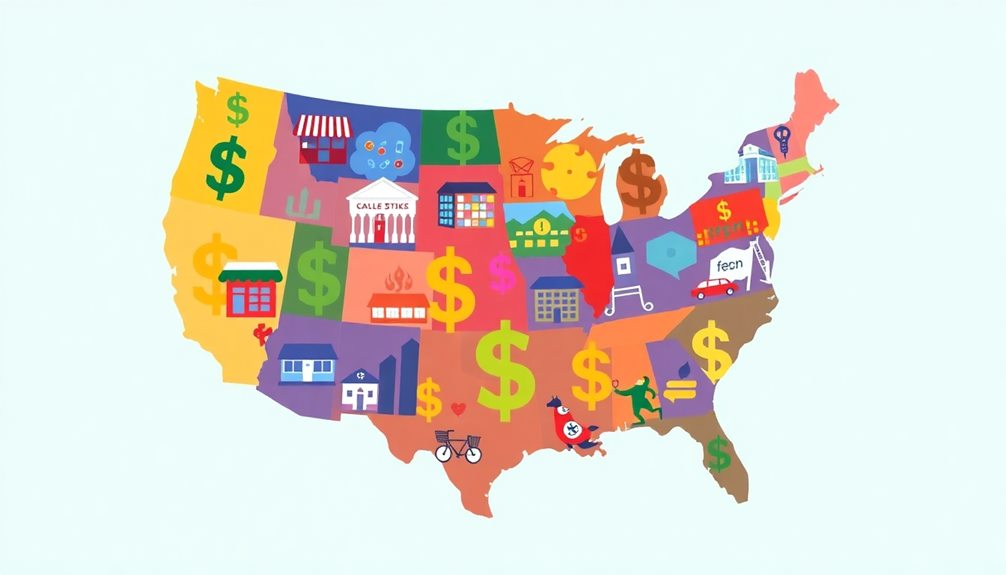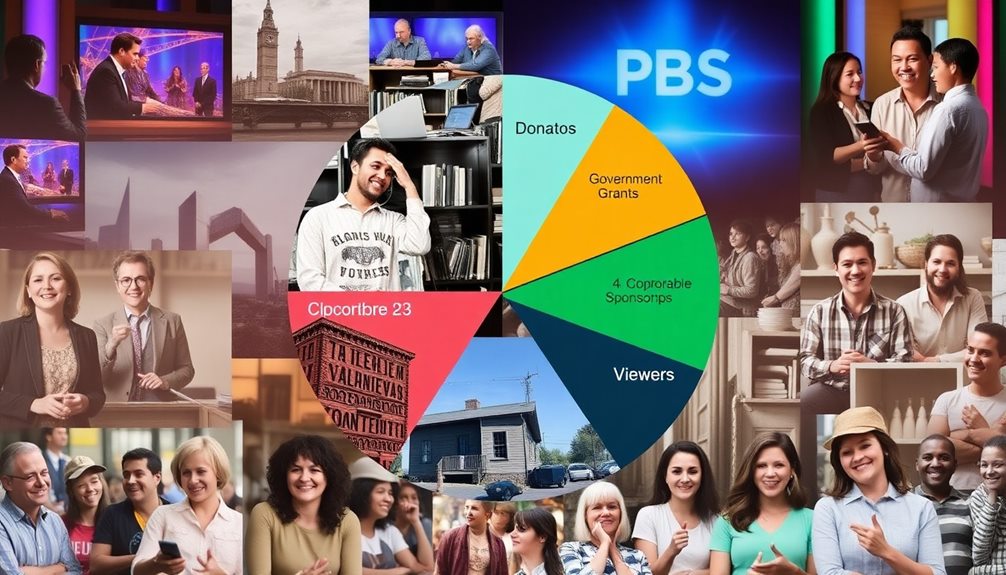In 2024, you've got plenty of funding options for your small business. Consider federal and state grants, like the SBIR program, which offers substantial support for R&D projects. Tax credits, like the Employee Retention Credit, can ease financial pressures. There are also targeted programs for minority and women-owned businesses, providing grants and loans tailored to your needs. Don't forget about alternative sources like crowdfunding and peer-to-peer lending for faster access to cash. With all these avenues available, you're well-equipped to find the right fit for your goals and needs as a business owner. Keep exploring to uncover more opportunities!
Key Takeaways
- Federal grants like SBIR and STTR provide significant funding for R&D, with amounts ranging from $50,000 to $1.8 million.
- State grants offer targeted funding for infrastructure improvements and job creation, varying by state and business sector.
- Accessibility grants support businesses in meeting ADA compliance, covering renovation and technology upgrades, with funding available up to $10,000.
- Tax credits, such as the Employee Retention Credit (ERC), provide substantial refunds for businesses retaining employees during economic challenges.
- Support programs for minority and women-owned businesses offer grants and contracts, fostering entrepreneurship and economic growth within these communities.
Government Grant Opportunities

When it comes to securing funding for your small business, government grant opportunities can be a game-changer. Numerous grant programs available can provide the financial boost you need without the burden of repayment.
For instance, federal research grants like the Small Business Innovation Research (SBIR) program offer substantial funding, ranging from $50,000 to $1.8 million, specifically for businesses engaged in R&D.
If you're a minority-owned business, don't overlook the resources offered by the Minority Business Development Agency (MBDA). Their grants and loans are designed to support business development initiatives in minority communities, ensuring you have the backing to grow and succeed.
State grants also present excellent opportunities. For example, Illinois' $3 billion Infrastructure Grants and the Texas Enterprise Fund target businesses focused on infrastructure improvement and job creation.
Additionally, while the Employee Retention Credit is a tax incentive, it's worth noting how it helps businesses retain employees during tough times, indirectly supporting your overall financial health.
Tax Credits and Relief Programs

When it comes to funding your small business, tax credits and relief programs can be a game changer.
For instance, the Employee Retention Credit can provide significant financial support if you kept employees on during the pandemic.
Additionally, understanding how state-specific regulations, such as Wisconsin IRA Withdrawals, can impact your financial strategies is essential.
Leveraging these options can help you navigate the economic challenges ahead.
Employee Retention Credit Benefits
Often overlooked, the Employee Retention Credit (ERC) offers substantial financial relief for eligible small businesses struggling since the COVID-19 pandemic. This refundable tax credit allows eligible employers to claim up to $26,000 per employee for wages paid between March 13, 2020, and September 30, 2021.
By effectively managing resources and understanding potential credits like the ERC, businesses can enhance their financial stability and better position themselves for future growth, especially in light of creating a retirement savings plan. It's a game-changer for businesses of all sizes, including tax-exempt organizations, especially if you experienced a decline in gross receipts or were subject to a government-ordered shutdown.
To leverage this benefit, businesses can retroactively claim the ERC by amending payroll tax returns. This can lead to significant cash flow relief, providing much-needed support to financially struggling businesses.
Unfortunately, many are still unaware of their eligibility for the ERC, which underscores the importance of consulting with tax professionals. They can help you navigate the complexities of the program and guarantee you maximize your available credits.
Don't miss out on this opportunity to bolster your finances; the ERC could be the lifeline your business needs to recover and thrive in a challenging economic landscape.
COVID-19 Economic Relief Options
Numerous economic relief options are available to help small businesses navigate the financial challenges brought on by the COVID-19 pandemic. One key option is the Employee Retention Credit (ERC), a refundable tax credit designed to support eligible businesses that retained employees during these tough times.
If you're an eligible business, you could receive up to $7,000 per employee per quarter for wages paid from March 13, 2020, through December 31, 2021.
To qualify for the ERC, you must demonstrate a significant decline in gross receipts or show that your operations were affected by government orders. This credit, extended through September 30, 2021, offers an essential lifeline to those struggling with ongoing economic impacts.
If you missed claiming the ERC, don't worry—you can retroactively file amended payroll tax returns. This could lead to substantial refunds, giving your business a much-needed financial boost.
Make sure to explore these COVID-19 economic relief options to help stabilize your business and retain your valuable employees during these uncertain times.
State-Specific Grant Programs

State-specific grant programs play a vital role in supporting small businesses across the country, providing essential funding tailored to local needs.
These grants can greatly impact job creation and economic development in your community, especially for diverse-owned businesses.
Here are a few key programs you might consider:
- Texas Enterprise Fund: Provides grants from $1,000 to $10,000 per qualified job created.
- Illinois Infrastructure Grants: A $3 billion initiative aimed at capital improvements for businesses.
- Minnesota Emerging Entrepreneur Loan Program: Focuses on aiding minority, low-income, and veteran-owned businesses.
- Skills for Small Business Grant: Offers up to $1,800 for training new employees in businesses with fewer than 100 employees.
Research and Development Grants

When you're looking for funding to fuel your innovative ideas, research and development grants can be a game changer.
Federal programs like SBIR and STTR offer substantial financial support, while state-specific grants can also cater to your unique needs.
It's crucial to understand the eligibility requirements and application processes to maximize these opportunities.
Federal R&D Opportunities
Federal research and development opportunities are an essential resource for small businesses looking to innovate and bring new technologies to market. These programs, including SBIR and STTR grants, can provide the financial backing you need to advance your projects.
Here are some key aspects to reflect on:
- Funding Amounts: SBIR grants exceed $1 billion annually, while STTR grants offer over $300 million.
- Collaboration: STTR requires partnerships with research institutions to facilitate technology transfer.
- Biomedical Focus: NIH specifically supports biomedical technology development, especially for urgent health challenges.
- Application Rigor: Expect a detailed application process that includes outlining project objectives, potential impacts, and financial projections.
To qualify, you'll need to meet specific eligibility criteria, which vary by program. This means you must be prepared to demonstrate how your project aligns with federal research and development goals.
State-Specific Research Grants
Research grants tailored to specific states can be a game-changer for small businesses aiming to innovate in areas like technology, health, and the environment. These state-specific research grants often focus on funding projects that foster economic growth while supporting local research institutions. For instance, programs in states like California and Texas encourage collaboration between small businesses and universities, driving advancements in various sectors.
| State | Key Focus Areas | Grant Amount Range |
|---|---|---|
| California | Technology & Health | $50,000 – $1.8 million |
| Texas | Environmental Sectors & Technological Advancements | $50,000 – $1.5 million |
| NIH | Biomedical Technology (COVID-19 Research) | Varies, often substantial |
The Small Business Innovation Research (SBIR) program complements these efforts by providing significant funding for small businesses engaged in federal R&D initiatives. Additionally, the National Institute of Health (NIH) emphasizes the importance of commercialization, requiring businesses to outline their plans for economic impact and tangible community benefits. By tapping into these grants, you can propel your business forward while making a positive difference.
Accessibility and Compliance Funding

As small business owners endeavor to create inclusive environments, accessibility and compliance funding plays an essential role in helping you meet legal standards and enhance customer experiences.
With various funding opportunities available, you can guarantee your business is both compliant and welcoming.
Consider these key aspects of accessibility funding:
- Accessibility Grants: Many local and state governments offer grants to assist with ADA compliance.
- Expense Coverage: Funding can cover renovations, signage, and technology upgrades.
- Legal Obligations: Meeting ADA compliance isn't just a requirement; it's vital for expanding your customer base.
- Resources: The U.S. Small Business Administration provides valuable information on available funding options.
For instance, the San Francisco Accessibility Grant offers up to $10,000 for small businesses to enhance ADA compliance and improve accessibility for individuals with disabilities.
By taking advantage of these funding opportunities, you not only fulfill your legal obligations but also create a better customer experience for everyone.
Prioritizing accessibility can help you stand out in the market, attract more customers, and contribute to a more inclusive society.
Rural Development Initiatives

Creating an inclusive environment is essential, but small businesses in rural areas face unique challenges that require targeted support. The USDA Rural Development Business Programs play a significant role in addressing these needs, offering loans, grants, and guarantees aimed at enhancing economic growth and job creation in rural communities.
In 2022, they allocated over $1 billion to help rural businesses access capital, which is critical for sustaining and expanding operations.
One key initiative is the Rural Business Development Grant (RBDG), providing grants ranging from $10,000 to $500,000 to support emerging private businesses in rural areas.
Additionally, the Rural Microentrepreneur Assistance Program focuses on microenterprises, offering grants and loans along with training and resources to entrepreneurs.
Programs like the Rural Innovation Stronger Economy (RISE) are designed to foster technology-driven development, improving access to essential resources for rural entrepreneurs.
Support for Minority-Owned Businesses

Support for minority-owned businesses is vital for fostering economic diversity and resilience. By providing targeted assistance, you can help these enterprises thrive.
Here are some key options available for support:
- Minority Business Development Agency (MBDA): Offers grants and loans specifically designed for growth and expansion.
- Texas Job Creators Grant: Provides $4,000 annually to diverse small businesses, focusing on job creation for minority-owned enterprises.
- Minnesota Emerging Entrepreneur Loan Program: Aims at job creation by offering loans to businesses owned by minorities, low-income individuals, and veterans.
- 8(a) Business Development Program: Assists socially and economically disadvantaged businesses, giving them limited competition for federal contracts.
These programs enhance access to vital resources and promote economic empowerment.
With the right support, minority-owned businesses can create jobs, foster innovation, and contribute considerably to the economy.
Every initiative, whether it's grants or loans, plays an essential role in leveling the playing field.
By participating in these programs, you're not just securing funding; you're also opening doors to federal contracts and increased opportunities for growth.
Your efforts can make a difference in the landscape of minority entrepreneurship.
Women-Owned Business Resources

While women entrepreneurs face unique challenges in the business landscape, numerous resources are available to help them succeed. One significant initiative is the Women-Owned Small Business (WOSB) Program, which allocates at least 5% of federal contracting dollars to women-owned small businesses, enhancing their access to training and contracts.
The Amber Grant for Women is another excellent opportunity, offering monthly grants of $10,000 and a $25,000 annual grant, complete with mentorship opportunities tailored for women entrepreneurs.
Similarly, the Center for Women Entrepreneurs provides grants of up to $5,000, supporting women-owned businesses that meet specific eligibility criteria.
For those near BMO branches, the BMO Celebrating Women Grant awards $10,000, promoting entrepreneurship among women in local communities.
If you're a service-disabled veteran, the Service-Disabled Veteran-Owned Small Business Program allocates at least 3% of federal contracting dollars to support businesses owned by service-disabled veterans, including women.
Additional Funding Options

Many small businesses today are exploring diverse funding options to fuel their growth and innovation. As emerging technologies like AI create new opportunities, it's essential for entrepreneurs to stay informed on AI job trends that may impact their hiring and operational strategies.
If you're looking for alternative funding options beyond traditional loans, consider the following:
- Crowdfunding: Platforms like Kickstarter and Indiegogo let you raise funds through community support while validating your business idea.
- Microfinance: Tailored for entrepreneurs in developing regions, these institutions provide small loans for those who mightn't qualify for traditional financing.
- Peer-to-Peer Lending: This allows individuals to lend directly to you, often resulting in lower interest rates compared to conventional methods.
- Business Credit Cards: These offer a quick and flexible financing solution for short-term needs and help build your business credit history.
Additionally, consider joining incubators or accelerators. They not only provide funding but also mentorship and essential resources to support your startup's growth.
Frequently Asked Questions
What Is the Best Source of Funding for Small Businesses?
When you're looking for the best source of funding for your small business, it really depends on your unique needs.
Grants can offer non-repayable capital, while loans provide structured repayment options.
You might consider crowdfunding to engage your community or explore angel investors for mentorship and capital.
The Small Business Administration also offers backed loans with flexible terms.
Evaluate what aligns best with your business goals and choose accordingly.
What Is the 000 Grant for Small Business in Wisconsin?
You might've heard of the $10,000 grant for small businesses in Wisconsin, designed to help those hit hard by the pandemic.
This grant can cover essential expenses like payroll and rent. To qualify, you'll need to show how your business faced challenges due to COVID-19.
The application process generally involves submitting financial documents and a business plan, with applications being accepted on a rolling basis to support ongoing recovery efforts.
What Is the ,000 Grant in Washington State?
The $10,000 grant in Washington State is designed to support small businesses impacted by the COVID-19 pandemic.
To qualify, you need to have fewer than 50 employees and show a revenue loss due to the pandemic.
Priority goes to businesses owned by women, minorities, and veterans.
You can use the grant for essential expenses like payroll, rent, and utilities.
Make sure to apply quickly to enhance your chances of receiving the funding.
Is the Government Giving Out Money to Start a Business?
Yes, the government does offer financial assistance to help you start a business.
You can find various grants, loans, and tax credits aimed at supporting new entrepreneurs. Programs like the Employee Retention Credit and SBIR grants can provide significant funding.
Additionally, local agencies often have state-specific programs tailored to your needs.
It's crucial to research these options thoroughly to see what fits your business goals and qualifications best.
Conclusion
As you explore funding options for your small business in 2024, remember there are plenty of fish in the sea. From government grants to tax credits and state-specific programs, you've got a wealth of resources at your fingertips. Don't hesitate to tap into support for minority and women-owned businesses, or rural development initiatives. With the right funding, your entrepreneurial dreams can take flight, so get out there and seize the opportunities waiting for you!










